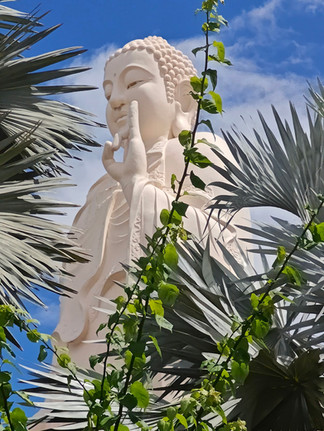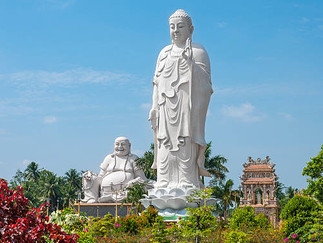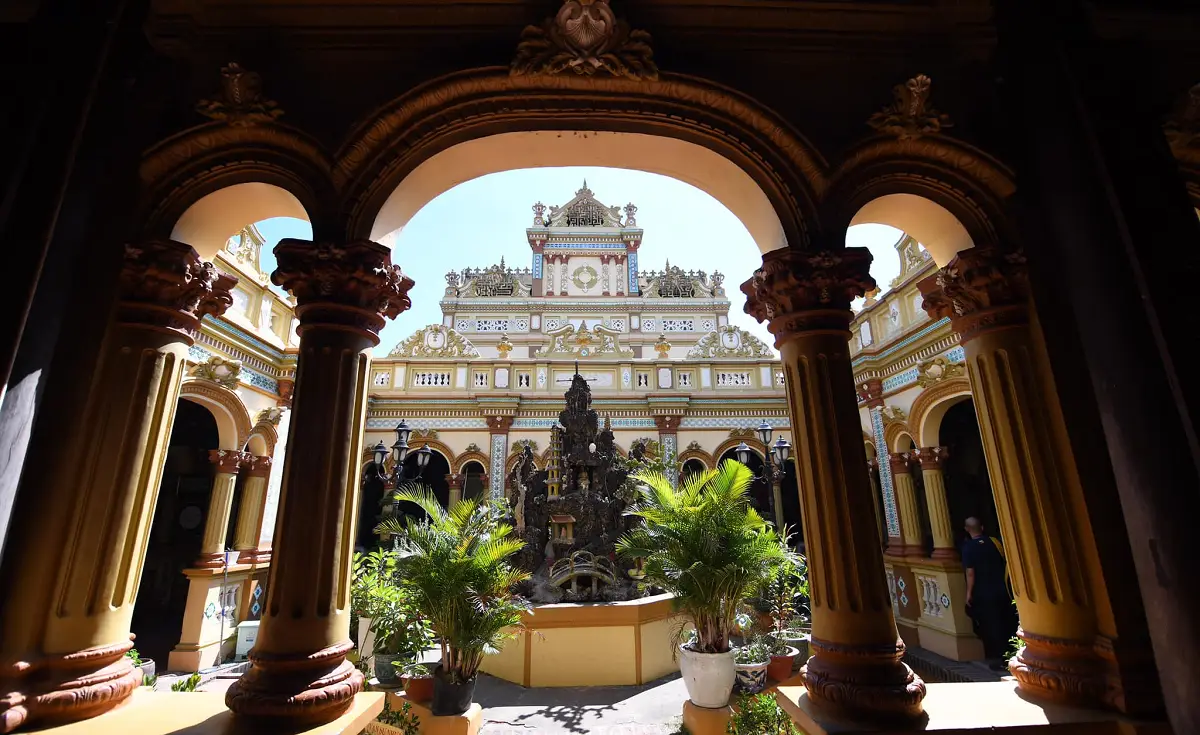Vính Tráng Pagoda - A Survivor of War and Time
- Shannon
- May 3
- 4 min read
Updated: May 4
Originally established in the early 19th century as a humble hermitage tucked beneath the shade of dense tropical foliage, Vĩnh Tràng began as a quiet sanctuary for meditation and retreat. Over time, this modest refuge evolved into one of the most celebrated and architecturally elaborate pagodas in southern Vietnam, located near the banks of the Mekong Delta. Spanning more than five acres of meticulously landscaped gardens, lotus ponds and sacred courtyards, the temple radiates both spiritual serenity and artistic grandeur. Officially completed and named in 1850, Vĩnh Tràng has endured its share of hardship, weathering the ravages of war, violent storms and the slow erosion of time.

The pagoda houses an extraordinary collection of over sixty sacred statues, masterfully crafted from wood, bronze and terracotta. Each figure reflects a unique facet of Buddhist devotion and artistry, offering visitors a profound glimpse into centuries of spiritual heritage. Among the most striking features are three monumental Buddha statues that dominate the temple grounds.
At the front of the complex stands a towering depiction of Amitabha Buddha, the embodiment of infinite compassion and celestial bliss, revered for guiding souls to the Pure Land. In the middle of the property, the joyful presence of a Laughing Buddha radiates warmth and abundance, his round belly and wide grin symbolising happiness, prosperity, and good fortune.

The Reclining Buddha is a powerful and serene representation of Gautama Buddha in the final moments of his earthly life, just before entering parinirvana, the ultimate state of liberation. Unlike ordinary death, parinirvana signifies the passing of one who has already attained enlightenment, a being who has broken free from the relentless cycle of samsara, the continuous loop of birth, death and rebirth, driven by desire and suffering. This statue is not merely a symbol of death, but a profound reminder of spiritual awakening and the promise of release from worldly suffering for those who follow the path of Dharma. It invites quiet reflection on impermanence, detachment and the eternal stillness that lies beyond the illusions of the material world.

The grounds surrounding the pagoda are adorned with tranquil lotus ponds. Scattered across the surface, lotus flowers bloom, their petals unfolding like sacred offerings to the heavens. According to local legend, these blossoms are far more than ornamental, they are living symbols of awakening. It is believed that the blooming flowers reflect the inner transformation of those who walk these hallowed paths, representing the gradual blossoming of wisdom and enlightenment within the minds and hearts of devoted visitors. Pilgrims come to the pagoda seeking solace, guidance and spiritual clarity. Tradition holds that those who arrive with pure intentions and sincere devotion are gently blessed with insight, subtle yet profound awakenings that, like the lotus, rise from the murky waters of suffering and confusion toward the light of understanding. Just as the lotus remains unstained by the mud from which it grows, so too can the soul remain untouched by worldly impurities as it journeys toward truth and transcendence.
During the turbulent years of war in Vietnam, Vinh Trang Pagoda stood not only as a spiritual beacon but also as a vital refuge for those caught in the crossfire of conflict. As violence swept through villages and uncertainty gripped the nation, many local residents fled to the pagoda’s protective embrace, seeking shelter beneath its sacred roofs. The monks, embodying compassion and selflessness, welcomed the displaced with open arms, offering food, safety and solace in the face of chaos. The temple, long regarded as a place of worship, became a living sanctuary, its bells echoing prayers for peace amidst the distant sounds of turmoil. This enduring legacy deepens the spiritual weight of Vinh Trang, transforming it into a symbol not only of religious devotion but also of resilience, unity and the unyielding hope of the Vietnamese people during their darkest hours.
Today, the sacred grounds serve a dual purpose, as both a spiritual centre and the administrative heart of the provincial Buddhist Association. The pagoda is lovingly maintained by devoted monks who not only uphold centuries-old traditions but also extend their compassion beyond the temple walls. They care for local children in need, offering guidance, support and a sense of belonging to those who have little else. With quiet reverence, the monks also tend to the ancient graves nestled throughout the grounds, honouring the memory of past guardians who once protected and preserved this hallowed space. In every act of service, from caring for the living to remembering the departed, the monks embody the timeless values of compassion, duty and spiritual stewardship.
Location : Chùa Vĩnh Tràng Nguyễn Trung Trực tp. Mỹ Tho Tiền Giang, Vietnam
How to get there : The pagoda is located 75km’s south of Ho Chi Minh City and takes a good hour and a half to reach. Vinh Trang Pagoda is usually the first stop included on most day tour itineraries on their way to the Mekong Delta.
Attraction Info : Vinh Trang Pagoda is usually the first stop for all day tours on their way to the Mekong Delta from Ho Chi Minh City. The pagoda is open from 9am - 5pm and entry is free. As this complex is run by monks who look after homeless and disadvantaged youth, a donation is appreciated but not expected.
Thanks for reading Vính Tráng Pagoda - A Survivor of War and Time. Check out more destinations here!




















